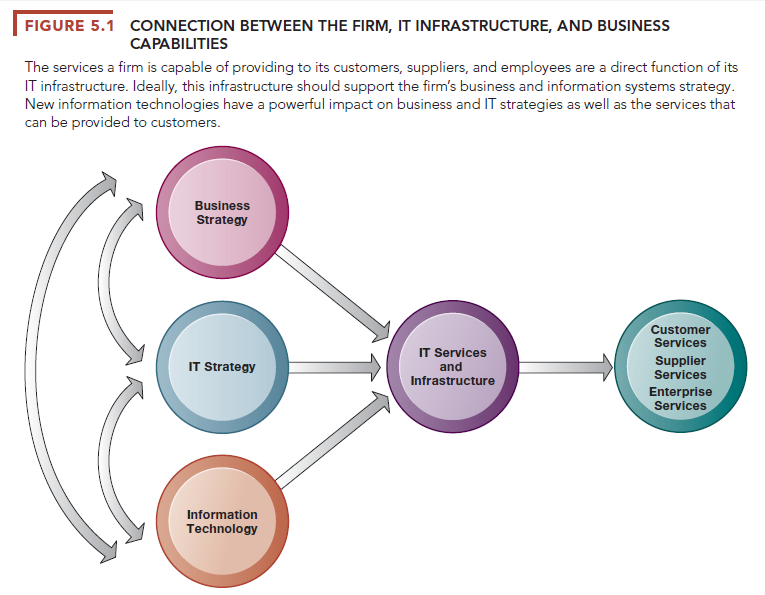An IT infrastructure consists of a set of physical devices and software applications that are required to operate the entire enterprise. But IT infrastructure also includes a set of firmwide services budgeted by management and composed of both human and technical capabilities. These services include the following:
- Computing platforms used to provide computing services that connect employees, customers, and suppliers into a coherent digital environment, including large mainframes, midrange computers, desktop and laptop computers, and mobile handheld and remote cloud computing services

- Telecommunications services that provide data, voice, and video connectivity to employees, customers, and suppliers
- Data management services that store and manage corporate data and provide capabilities for analyzing the data
- Application software services, including online software services, that provide enterprise-wide capabilities such as enterprise resource planning, customer relationship management, supply chain management, and knowledge management systems that are shared by all business units
- Physical facilities management services that develop and manage the physical installations required for computing, telecommunications, and data management services
- IT management services that plan and develop the infrastructure, coordinate with the business units for IT services, manage accounting for the IT expenditure, and provide project management services
- IT standards services that provide the firm and its business units with policies that determine which information technology will be used, when, and how
- IT education services that provide training in system use to employees and offer managers training in how to plan for and manage IT investments
- IT research and development services that provide the firm with research on potential future IT projects and investments that could help the firm differentiate itself in the marketplace
This “service platform” perspective makes it easier to understand the business value provided by infrastructure investments. For instance, the real business value of a fully loaded personal computer operating at 3.5 gigahertz that costs about $1,000 and a high-speed Internet connection is hard to understand without knowing who will use it and how it will be used. When we look at the services provided by these tools, however, their value becomes more apparent: The new PC makes it possible for a high-cost employee making $100,000 a year to connect to all the company’s major systems and the public Internet. The high-speed Internet service saves this employee about an hour per day in reduced wait time for Internet information. Without this PC and Internet connection, the value of this one employee to the firm might be cut in half.
Source: Laudon Kenneth C., Laudon Jane Price (2020), Management Information Systems: Managing the Digital Firm, Pearson; 16th edition.

I have read a few good stuff here. Certainly worth bookmarking for revisiting. I wonder how a lot effort you set to make such a wonderful informative site.